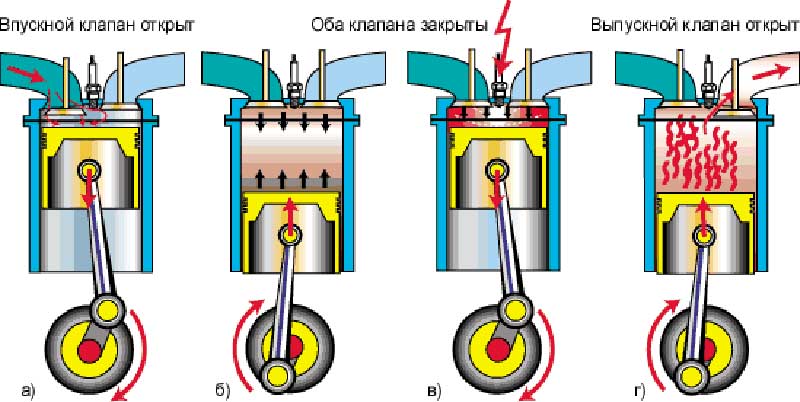
4-stroke engine
Content
4-bar waltz
How does it work?
With the exception of a few rare two-strokes, the four-stroke is almost the only type of engine found on our two wheels today. Let's see how it works and what are its components.
The valve engine was born in the 1960s ... in the 19th century (1862 for patent applications). The two inventors would have the same idea almost simultaneously, but internationally, the German Otto beats the Frenchman Beau de Roche. Perhaps due to its somewhat predetermined name. Let's give them their due, because even today our favorite sport owes them a proud candle!
Like the 2-stroke cycle, the 4-stroke cycle can be achieved with a spark ignition engine, more commonly referred to as "gasoline," or compression ignition, more commonly known as diesel (yes, there are 2-stroke diesel diesel systems!). End of the bracket.
A more complex universe ...
The basic principle always remains the same, sucking in air (oxidizer) that is mixed with gasoline (fuel) to burn them and thus use the energy released to drive the vehicle. However, this is in contrast to the two steps. We take the time to do everything well. In fact, this invention of the camshaft (AAC) is very clever. It is he who controls the opening and closing of valves, types of "engine filling and drain valves". The trick is to turn the AAC 2 times slower than the crankshaft. In fact, performing AAC requires two crankshaft towers to complete a full cycle of open and close valves. However, AAC, valves and their control mechanism create a mess, so weight and manufacturing are more expensive as well. And since we only use combustion once every two towers, at the same rate we release less energy and, therefore, less energy than a two-stroke ...
miniature photo 4-stroke cycle
Прием
It is the release of the piston that causes the vacuum and, therefore, the suction of the air-gasoline mixture into the engine. When the piston is lowered, or even a little earlier, the intake valve opens to bring the mixture into the cylinder. When the piston arrives at the bottom, the valve closes to prevent the mixture from being pushed out, raising the piston. Later, after examining the distribution, we will see that here, too, we will wait a bit before closing the valve ...
Compression
Now that the cylinder is full, everything is closed and the piston rises, thereby compressing the mixture. He pushes it back to the candle, which is very cleverly located in the combustion chamber. The contraction of the joints and the resulting increase in pressure raise the temperature, which will help burn. Shortly before the piston reaches the top (high neutral point, or PMH), the spark plug ignites ahead of time to start combustion. Indeed, it is a bit like fire, it does not go away instantly, it has to spread.
Burning / relaxing
Now it is heating up! The pressure, which increases to about 90 bar (or 90 kg per cm2), pushes the piston hard back to the low neutral point (PMB), causing the crankshaft to turn. All valves are always closed to take full advantage of the pressure, because this is the only time energy is recovered.
Exhaust
When the piston finishes its downward stroke, the energy stored in the crankshaft will return it to the PMH. It is here that the exhaust valves are open to release flue gases. Thus, the empty engine is ready to suck in fresh mixture again to start a new cycle again. The engine was rotated 2 times to cover a full 4-stroke cycle, each time about 1⁄2 revolutions per fraction of the cycle.
Comparison box
More complex, heavier, more expensive and less powerful than the 2-stroke, the 4-stroke benefits from superior efficiency. sobriety, which is 4 times explained by the best decomposition of various phases of the cycle. Thus, at equivalent displacement and speed, a 4-stroke is fortunately not twice as powerful as a 2-stroke. In fact, the displacement equivalence originally defined in the GP motorcycle, 500 two-stroke / 990cc four-stroke, was favorable to him. Then, during the 3 cc episode ... We banned twice so they don't come back ... to the game this time! However, to play even, the four strokes must rotate much faster than the drilled cylinders. For example, it cannot do without some noise problems. Hence the introduction of double mufflers on TT valve engines.
